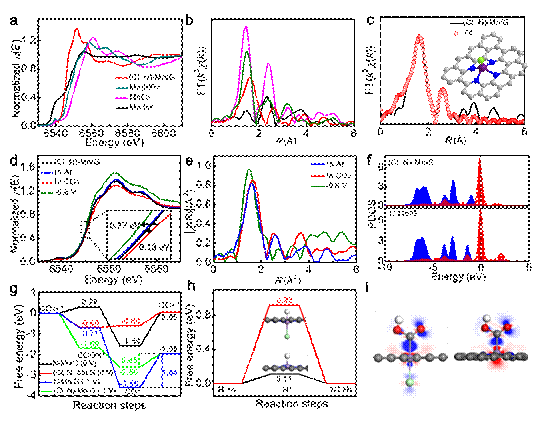| Mn-Based Heterogeneous Catalyst with Halogen and Nitrogen Dual-Coordination Towards High-Efficiency Electroreduction of CO2 |
| From: PublishDate:2020-07-31 Hits: |
Excessive consumption of fossil fuels causes huge energy and environmental problems. The electrocatalytic CO2 conversion to high-value fuels and chemicals provides an ideal way to alleviate the energy and environmental problems. Particularly, the development of cheap and earth-abundant electrocatalysts is of great significance. A team from Institute of Chemistry, Chinese Academy of Sciences, conducted in-depth research on the use of cheap manganese-based catalysts for electrocatalytic CO2 reduction. The results were published in Nature Communications (2019, 10: 2980) in July 2019, and selected as a highlight paper by the editors. Manganese is the third element with high natural abundance next to iron and titanium among transition elements. However, its studies on heterogeneous electroreduction of CO2 are limited, and its activity is far lower than that of other metal base catalysts such as Fe, Ni and Co. The research group designed a manganese atom catalyst with halogen (Cl, Br, I) and nitrogen dual-coordination. They proved that this structure can improve the electronic structure of manganese atom and significantly increase its electrocatalytic activity in the process of CO2 reduction. At overpotential of 0.49 V, the maximum CO Faraday efficiency of 97% was achieved and CO generation frequency could reach a value as high as 38347 h-1. The atomic coordination structure of the active manganese center was obtained by XAFS technique carried out at 1W1B-XAFS station of Beijing synchrotron radiation facility (BSRF). The results indicate that manganese atom is coordinated with one chlorine and four nitrogen atoms (Figure 1a-c). In situ X-ray absorption experiment and density functional theory calculations (Figure 1d-i) further show that chlorine ligand can modify the electronic structure of active manganese atoms in the catalyst. This reduces the free energy barrier for intermediates formation in the catalytic process, thus greatly improves CO2 reduction to CO. In this work, synchrotron radiation technology is crucial to uncover the deep structure of the catalyst and in situ tracking the catalytic reaction.
Figure 1 Study on the structure of manganese catalyst and its electrocatalytic reduction mechanism of CO2. Article: Bingxing Zhang, Jianling Zhang,* Jinbiao Shi, Dongxing Tan, Lifei Liu, Fanyu Zhang, Cheng Lu, Zhuizhui Su, Xiuniang Tan, Xiuyan Cheng, Buxing Han, Lirong Zheng and Jing Zhang, Manganese acting as a high-performance heterogeneous electrocatalyst in carbon dioxide reduction. Nat. Commun., 2019, 10, 2980. |
|
|
| Chinese
- Metal-free efficient photocatalyst for stable visible water splitting——Top ten major scientific progresses in China in 2015
- The nano-resolution imaging platform was awarded the first rate prize of Beijing Science and Technology in 2014
- Beamline 1W1 of BSRF started to runoperate in the couplingparasitic mode of BEPCII
- Synthesis of High Performance Polymer Materials for Field Effect-Transistors
- Surfactant molecular aggregates in green solvents
- GIXRD has played an important role in the characterization of organic thin-film transistors
Science Highlights
Home /
Copyright © 2011 - 2012 Beijing Synchrotron Radiation Facility


